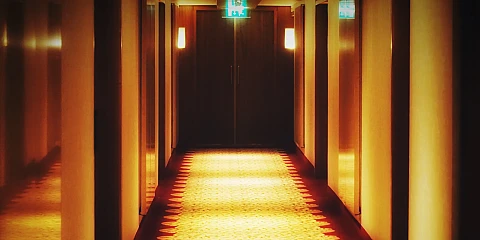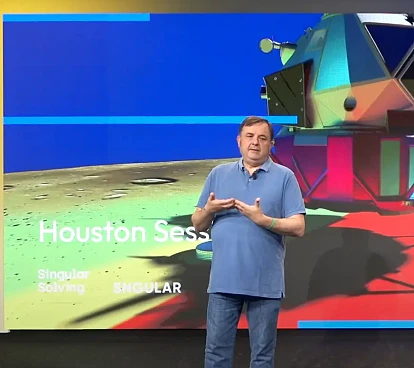
Innovative by Design: creativity to tackle complex problems
October 24, 2024
As a passionate innovator, I recently realized that I have spent almost my entire career on the edge of the liminal, even without knowing what to call it. The fact is, the concept of liminality has been widely explored in anthropology, literature, and architecture, among others, but it is maybe not so well-known in technology and sometimes more focused on the user experience. First enunciated back in 1909 by ethnographer Arnold van Gennep in his work “Les rites de passage”, he referred to liminality as the transitional phase in a rite of passage where an individual is in an ambiguous state between their old and new status in a society.
In the context of innovation in engineering, liminality can be seen as the transitional phase between the identification of a problem and the implementation of a solution. This period, marked by ambiguity and potential, offers an opportunity for disruptive new approaches to be tested, refined and effectively productized.
Throughout my career in technology innovation, I have observed two prevailing trends among my colleagues: while some tend to progressively specialize in specific domains, others, like myself, enjoy working at the boundaries. This often means that the liminal innovator is surrounded by colleagues who are more expert in their respective fields than themselves, living with the constant, sometimes pleasant and other times terrifying, sensation of being the least knowledgeable person in the room.
While some might consider this lack of specialization a disadvantage, others may argue that it provides a competitive advantage. Nevertheless, whether specialist or generalist, both profiles have much to contribute when it comes to complex problems and need to work together to overcome them. Tackling such problems requires the ability to understand the business, extensive knowledge of the technology ecosystem, an understanding of the sciences of complexity, all intertwined with the psychology of human behavior -the so-called X factor. These are four very distinct domains of knowledge and perspectives to account for, all of which require a team with high levels of expertise and a broad capacity to navigate the liminal domain.
In this post, we provide an overview of what design specialists bring to our table of CPS. Over the past few years, I have had the opportunity to work with excellent professionals in the discipline, from whom I have learned how much their perspective and creative capabilities can contribute to teams primarily composed of technologists. Beyond their obvious expertise, their application of basic design principles—such as perception, empathy, and observation—creates a multiplying effect that enhances the team's ability to confront new challenges. We can call it design thinking, creative thinking, or lateral thinking. Labels aside, the reality is that applying creativity to complex problem-solving has immense potential to contribute to the success of innovative initiatives.
In 2007, David Snowden highlighted that the complex domain is prevalent in the business world, much more so than most people in leadership positions realize. In the context of decision-making, Snowden proposes to analyze each of the situations in a division into 5 domains, in order of complexity, from the simplest to the most disordered, having passed through the complicated, the complex and the chaotic domains. This is the so-called Cynefin framework, which proposes a 3-step process to be followed for each of them depending on the domain conditions. For the complex domain, the framework suggests focusing on probing, sensing, and responding to recognize patterns that allow us to provide the best possible response to the problem at hand. This approach doesn't sound too far from the 3I core activities (Inspiration, Ideation, Implementation) that underpin design thinking according to IDEO.
Actually, we can establish a reasonable parallelism between the sensing process and the inspiration stage, where we become aware of our surroundings and the boundary conditions of our domain. Ideation involves a conscious recognition of patterns and understanding how changes in the variables of our problem affect the outcomes, ensuring our ideas are grounded in reality. Implementation is crucial for moving beyond the liminal state and effectively transitioning from theory to practice.
The resemblances don’t stop there. The Cynefin Co defines sense-making as key to the practical application of the Cynefin framework, emphasizing the voices and interpretations of people at the center of the problem. Similarly, designers often talk about human-centered design, where the goal is to build a deep empathy with the people you are designing for.
In our approach to CPS, we recognize that the understanding of the X factor -the human being, their psychology, fears, biases, behaviors and motivations- is integral to adequately resolving the problem. While aiming to cover a broader perspective than design thinking, both disciplines share a key common ground: people -humans, with their needs and desires- at the center of the problem.
How to navigate the Knowledge Funnel
Let’s delve further into complex problems and how creativity can help us to confront them. It’s important to take into account that we are trying to solve a problem without knowing if it has a solution, and where the relationships between their different parts are anything but evident. In this scenario, we often barely know where to start. Sometimes we even need to question whether we are solving the right problem . Is in these moments that techniques historically related to product design, such as ux research, prototyping, and testing, reveal their potential. This is particularly true during exploratory phases and in cases where the project’s strategic nature carries higher risk and potential.
Let’s look into the history of the now well-known Airbnb. Back in 2009, the company was facing significant financial problems. Their weekly income was about $200, which, when split between three founders in San Francisco, resulted in substantial losses. The three partners had to act quickly to solve what was, for them, a mystery.
They decided to follow a heuristic approach. One of the co-founders realized that the pictures in their approximately 40 ads were bad. Very bad, indeed: non-professional, dark images that didn’t clearly show what customers were booking. So they decided to go against the widely extended idea back then in Silicon Valley that everything had to be scalable.
The partners decided to take a professional camera and get down to the field. They visited their advertisers and helped them take high-resolution photos of their rooms to improve their ads. This approach was far from a scalable business model, but they needed to understand the problem, and for that, they needed to experiment.
One week later, their income had doubled. It was the first increase they had seen in 8 months. The idea had worked, so now they had to refine it and delve deeper to make it scalable and algorithmic, so that it could eventually be coded into their app.
In fact, this experience strongly impacted the company strategy in the years to follow. Influenced by this key success, they promoted the culture of Let People Be Pirates, encouraging those with an idea to “venture into the world, test it and come back with its story”. Fundamentally, everyone at the company is encouraged to ship new features as soon as possible, and track them so they can evaluate their impact. A culture of inspiration, ideation and implementation taken to the extreme, where the product lives almost constantly in a liminal status and open for change.
That same year, Roger Martin published his book “The Design of Business: Why Design Thinking is the Next Competitive Advantage". It revolves around the idea that the innovation process follows the so-called knowledge funnel, which consists of the following phases:
- Mystery: Exploring undefined problems to identify patterns and generate ideas (realizing that the pictures were bad).
- Heuristics: Generating significant models that allow us to apply these ideas to the problem practically, so we can measure their impact (taking the pictures with a professional camera).
- Algorithmics: Perfecting heuristics so that they are converted into repeatable and scalable processes (the following phase, making the idea into a product feature).
- (Code): implement the idea in the final product. This is bracketed because only the first three phases are established in the original book. The fourth phase is included in a recent Medium post by the same author.
Coincidence or not, the steps followed by the Airbnb founders fit perfectly into Martin’s ideas. They also have a clear parallelism with Dervin’s sense-making theory first explored in the 1970s and 80s and that closely relates to the Cynefin framework as we previously stated. Faced with an unidentified problem (their lack of income), the Airbnb founders identified the poor quality of their images as one critical issue. This discovery provided the necessary information to bridge the gap using an empirical approach—taking high-quality pictures—which led to a successful outcome. We can observe an alignment between sense-making, complex-problem theoretical frameworks, design thinking, and real-world applications with strategic impact. And Airbnb is not an isolated case; numerous examples exist where design thinking is effectively applied to business strategy.
A canonical case of design thinking application is that of Kaiser Permanente (KP), one of the largest healthcare providers in the US. Back in 2003, they hired IDEO to help them improve their innovation methodology. Within their collaboration, they developed a series of impactful projects, for example, the MedRite program.
This project aimed to reduce the percentage of errors in the drug administration to patients. In 1999, a report from the Medical Institute of the US quantified the cost of medical errors between $17 and $29 billion annually, with a significant portion related to drug errors, aside from the personal costs for both patients and professionals.

When the hospital’s professionals were asked what they thought was wrong with the process, they usually responded “Nothing”. However, when asked to draw how they felt, their drawings reflected sadness and overwhelm. During the observation phase, the innovation team at KP detected that the healthcare professionals were interrupted up to 17 times in a single drug pass. Most interruptions were aimed to offer relevant information about other patients, resulting in a high cognitive load and potential distractions.
Many solutions were proposed, some as advanced (or we might even say a bit crazy) as a fully autonomous hospital bed. However, one nurse mentioned that what she really needed was a nametag with a “Leave me alone” message. The idea was there. It might have always been there subliminally, never put through the liminal domain. But now, it only had to be tested. The team decided to identify personnel during critical processes with a bright yellow band. Sounds easy enough, and by early 2008, 75% of KP’s hospitals had implemented it. In September 2010, less than three years later, the positive economic return had more than doubled the project costs, alongside the obvious intangible improvements in patient care and professional wellbeing.
Similarly to Airbnb, the success of these projects had a great repercussion in the culture and strategy for KP. In 2009, they had formed a small team called The Innovation Consultancy to “leverage design thinking to implement innovations at the frontlines of health care delivery”. 15 years later, this small team has evolved into KP Design Consultancy, who not only provide innovation services for Kaiser Permanente, but also encourage the extension of a human-centered design culture for the rest of the organization.
Many other companies are promoting the idea of encouraging their workers to develop creativity and propose disruptive innovations that impact them. Most readers are likely familiar with the famous case of Google, Gmail and the 20% policy. One of the company’s flagship products was conceived during that 20% of working time that Google allows their employees to invest in side projects. What you may not know is that this policy is neither as new nor as exclusive to the tech sector as you might think.
Back in 1948, 3M introduced a policy known as the 15% culture, a percent of the time that their personnel can work on their own ideas that had potential for the company’s business. Probably 3M’s most iconic product, the Post-It note, was developed during that time as a creative response to a product, its glue, that had been developed as a failed product for a different goal. Encouraging lateral thinking clearly has a corporate return.
Does this mean that Design Thinking is the global solution for everything? Is it Maslow’s golden hammer for Complex Problem Solving? Of course not. Part of the intrinsic beauty of complex problems is that they are non-generalizable by nature, so finding a way to tackle them becomes a part of the problem itself. We would be completely wrong to say or think that only one discipline or technique is enough.
Actually,that is precisely the strength of Unconventional CPS: our commitment to a transdisciplinary team where professionals with different backgrounds and expertise work together to offer our customers the best possible solutions. Our approach is rooted in the understanding that we are building upon a complex metadiscipline on the limit of the liminal. And it is precisely when you aim to tackle seemingly impossible challenges and extremely complex situations due to the nature of the issues or the implications of its approach, that there is no other way to confront them.
In this context, having a team of experts working on strategic design problems is crucial to contribute and incorporate design and user experience during the early stages of the problem analysis. A team with proven experience in human-centered design, from whom the rest of professionals at Unconventional CPS can learn daily, helps to turn our preconceived ideas upside-down and ensures that creativity plays a significant role in the complex-problem solving process.
Because our range is where our competitive advantage lies.
Our latest news
Interested in learning more about how we are constantly adapting to the new digital frontier?

Corporate news
April 22, 2024
Javier Recuenco, new Strategy Advisor at SNGULAR

Corporate news
April 11, 2024
Why Unconventional CPS Had to Be Created

Corporate news
April 2, 2024
Awaken the sleeping giant of your company!

